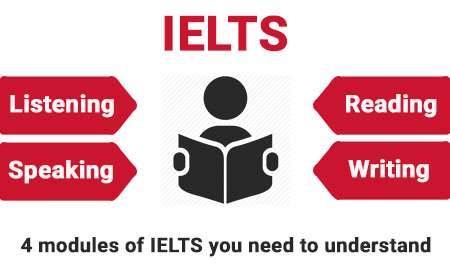IELTS TEST PATTERN
IELTS is a test for English language proficiency. Though it does not have any particular syllabus, it follows certain patterns:
Listening Test:
- This module is the same for both Academic and General Training
- The Listening test consists of 4 sections of recordings in the voices of native English speakers; the contexts of these recordings/sections are usually social or instructive.
- Sections 1 & 3 are dialogues/discussions between two to four individuals, and Sections 2 & 4 are monologues/discourses.
- The recordings are played only once and candidates are required to answer 40 questions, 10 for each section.
- There are a variety of question-types: notes/summary/table/flow-chart completion, multiple-choice, short-answer questions, sentence completion, labeling diagrams/maps/plans, matching, and classification.
Reading Test:
- This module differs for Academic and General Training
- The Academic module consists of 3 academically oriented passages from different sources. The texts are in an order of increasing difficulty. The texts may contain illustrations. There are a total of 40 questions, with each text having 12-14 questions. The questions are designed only to check English comprehension ability and not the knowledge of the candidates.
- The General Training module consists of texts on general topics/related to work. There are 3 sections, which might have 2-3 short texts or several shorter ones, and are of increasing difficulty. There are a total of 40 questions: Section 1 has 14, and Sections 2 and 3 each have 13 questions. Here too, questions are designed only to check English comprehension ability.
- Question-types which are common for both Academic and General Training: multiple-choice, identifying information (True/False/Not Given), identifying the writer’s views/claims (Yes/No/Not Given), matching information, matching features, matching sentence endings, sentence completion, notes/summary/table/flow-chart completion, labelling a diagram, and short-answer questions. For General Training candidates, there is one more question-type: multiple matching.
Writing Test:
- For the Academic test, task 1 is related to data interpretation in which a candidate is required to depict, outline, and write a report on a diagram or graph (line chart, structured presentation, pie graph, and table), related to any object, event, process (stages), flow-chart, or a process map, in not less than 150 words.
- The source of information for these diagrams and graphs can be any data base around the world.
- For the General Training test, task 1 consists of letter writing (formal, semi-formal, and casual).
- A situation is introduced as a cue, either to request data or explain the situation. Candidates must compose a letter with a minimum word limit of 150 words.
- Task 2 is the same for both Academic and General Training, and is about formal essay writing of about 250 words.
- The questions can look for a candidate’s perspective/argument/suggestions, on an issue, and/or ask the candidate to put down the advantages and disadvantages of an issue/situation.
Speaking Test:
- The structure of the test is the same for both Academic and General Training
- This test assesses a candidate’s communication skills in English and is divided into three sections.
- In Part 1, general introductory questions are asked from the candidate on a range of familiar subjects, e.g. home, family, profession, hobbies, likes, dislikes, etc.
- In Part 2, the candidate is asked to speak on a particular topic, covering 3 to 4 wide areas about the topic. The candidate is given 1 minute to prepare and make notes, and then speak on the subject for 2 minutes.
- In Part 3, various questions are asked on the topic you have spoken about in Part 2. These questions require detailed answers.





